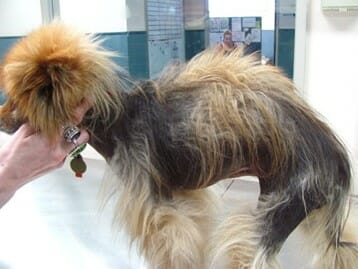
Alopecia X is a name given to a skin condition in the dog resulting in non-inflammatory hair loss. Other names used for the same condition have included adrenal sex hormone imbalance, wooly syndrome, coat funk, black skin disease, pseudo-cushings, and follicular growth dysfunction of plush coated breeds. I now call this alopecic condition hair cycle arrest (HCA), as this name describes what has happened; the hair cycle has stopped and there is a cessation in new hair growth.
Hair cycle arrest occurs in the Pomeranian, Schipperke, Malamute, Samoyed, Chow Chow, Keeshound, and miniature and toy poodle. These are plush coated breeds. The onset may occur between 1-10 yrs of age and there is no sex predilection. Both intact and spayed/neutered dogs may be affected.
Hair cycle arrest is characterized by a progressive non-pruritic (non-itchy) alopecia (hair loss) where there is an initial loss of the primary hairs and the development of a dull and dry hair coat (wooly lamb). It affects the trunk, tail, frictional areas and thighs. The head and limbs are spared. Hair regrowth may occur at sites of trauma to the skin (e.g. where a skin biopsy is performed). The skin is typically hyperpigmented (black-grey). The rate and nature of hair loss is variable among dogs. Some dogs develop and retain the wooly coat and some develop complete alopecia.
It is important to note that dogs with hair cycle arrest are otherwise healthy and do not have signs of other endocrine system abnormalities – which may also cause a non-inflammatory alopecia. The cause of HCA is not known, but there have been many proposed and tested theories. Most have been disproven in scientific studies. Is this a growth hormone deficiency? No. Is this a castration responsive dermatosis? No. Is this a mild form of pituitary dependent hyperadrenocorticism? No. Is this due to abnormal steroidgeneises? No. Is this a mutation in the canine 21 hydroxylase gene? No. Is there an increased activity of the hair follicle estrogen receptor activity preventing normal follicular cycling? No.
Diagnosing Alopecia X
The newer theories being evaluated are focusing on genetics and hormone receptors on the hair follicle. There are extrinsic (hormones) and intrinsic (cytokines, growth factors, receptors) factors that affect the hair cycle. Complex interactions are involved in anagen (growth phase of the hair cycle) initiation. It seems that hair follicles in affected dogs require both stimulation from another to be determined molecule AND blocking of the estrogen hormone receptor.
The diagnosis is made by knowledge of the breed, history, and course of hair loss. In addition, the absence of other clinical signs of an endocrinopathy is important, as the hair loss mimics other common causes of alopecia. Tests that may be done to screen for other conditions include CBC, chemistry profile, thyroid testing, skin biopsy.
Skin scrapings and skin surface cytology are done to ensure there are no parasites (demodex) or secondary skin infections causing hair loss. If uncertain about the presence of other hormonal conditions, additional tests such as thyroid function tests, an ACTH stimulation test, low dose dexamethasone test, Urine cortisol to creatinine ratio, abdominal ultrasound, and urinalysis may be done. In hair cycle arrest these tests would all be normal. If adrenal sex hormone testing is done, there may be abnormalities, but the abnormalities may not be reflective of what is causing the hair loss.
Treating Alopecia X
This is a cosmetic condition, so it is not unreasonable to monitor the dog for the onset of other endocrinopathies and provide no treatment. I examine them every 3-6 months if desired or if there is any change in the pet that warrants evaluation of other endocrine systems. Sometimes, affected dogs require treatment of secondary infections or topical therapies to manage the hydration and appearance of the skin.
Most veterinary dermatologists will prescribe melatonin in effort to stimulate hair growth. This is a neurohormone produced in vertebrates by the pineal gland in response to dark and decreasing day length. In normal animals, it influences the onset of hair growth as the length of the photoperiod shortens- so that one gets a winter hair coat. In those affected dogs that do regrow hair with melatonin, it may increase in the number of anagen hair follicles, increase the length of the hair shaft, and decrease in hyperpigmentation. It is not proven to affect the concentration of adrenal sex hormone intermediates or cortisol.
Melatonin administration may result in partial to complete hair regrowth in 30-40% of affected dogs. They may lose hair again, even whilst on melatonin. Melatonin is safe, but should be used with caution if there is concurrent diabetes mellitus. The dose is 3 to 9 mg orally every 8-12 hrs. I administer for 3-4 months and reassess. Melatonin implants are also available. Other treatments one might come across include mitotane and trilostane. In my opinion, in hair cycle arrest, the potential risk of side effects with the use of mitotane or trilostane outweigh the potential benefit of possible hair regrowth in this otherwise cosmetic condition.
Do you think your dog is suffering from Alopecia X? Find a MedVet dermatologist near you!
Image Source: vetbook.org